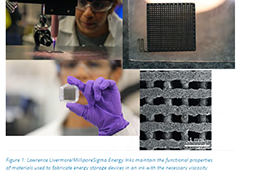
Fibers of Cellulose acetate under the microscope. Cellulose acetate is a synthetic material used for analog films, cigarette filters, glasses and many other things.
Cellulose—one of the most abundant organic polymers in the world—is an ideal material in many ways, as it is robust, biorenewable, biodegradable and versatile. Because of this, many researchers have investigated it as a replacement for petroleum-based polymers in 3D printing. However, 3D printing with cellulose comes with major obstacles, many due to the hydrogen bonding process the material undergoes.
Researchers from the Massachusetts Institute of Technology (MIT) may have found a solution, establishing a novel process for 3D printing with cellulose using the widely available cellulose derivative, cellulose acetate.
The process was outlined in a paper, lead authored by Sebastian Pattinson, Ph.D., post doctorate fellow in the department of mechanical engineering at MIT, and published in the journal Advanced Materials Technologies earlier this year. It was co-authored by associate professor of mechanical engineering A. John Hart, the Mitsui Career Development Professor in Contemporary Technology at MIT.
In an exclusive interview, Pattinson spoke with R&D Magazine about the use of cellulose acetate as a new 3D printing material, as well as its potential benefits and applications.
R&D Magazine: Why has cellulose been considered as a 3D printing material?
Pattinson: Cellulose is the most abundant organic polymer in the world; it is the primary structural component that many things are made of, including paper. It is extensive, biorenewable and biodegradable. In addition, it is also mechanically very robust and mechanically very versatile—it is used in a large variety of different products, furniture, medical devices, pharmaceuticals, clothing, etc.
However, a lot of the processes that are used to make products containing cellulose are kind of inflexible. Existing manufacturing processes for cellulose tend to be either subtractive or assembly based, they don’t really give you a lot of flexibility. As a result of that, a lot of people have tried to develop a 3D printing process for cellulose, because 3D printing allows you to inexpensively customize products. Every printer can produce, to some extent, arbitrary geometries, or at least give you a lot of flexibility in the kind of geometries you can produce without needing to retool. In addition, 3D printers can often produce more complex geometries with hallow spaces that many other processes can.
R&D Magazine: What challenges have researchers faced in the past trying to 3D print with cellulose?
Pattinson: 3D printing with cellulose has been very difficult, in particular because of the hydrogen bonding in cellulose between the cellulose molecules. That hydrogen bonding has two main effects. Specifically, when you have a polymer and you want to 3D print it, you have to heat it up until it becomes flowable and then you can extrude it through a nozzle and deposit it layer by layer. However, because of the hydrogen bonding, cellulose will actually thermally decompose before it becomes flowable. Also, if you want to dissolve cellulose or put it in suspension, the hydrogen bonding will lead those solutions or suspensions to become extremely viscous, even at very low cellulose loading. Previous work regarding 3D printing cellulose has focused on either using the cellulose as a low-density filler material in another matrix, typically another polymer, or using it to produce aerogel-like structures. Those methods apply to some applications, but in applications like furniture, or pharmaceuticals, we really need to have a full-density cellulose product.
R&D Magazine: How does your research tackle these challenges?
Pattinson: We saw hydrogen bonding as a problem, so we came up with the idea of temporally reducing the strength of hydrogen bonding to enable a 3D printing process. The way we ended up doing that is by not printing cellulose directly, but rather using a cellulose derivative called cellulose acetate. The number of hydrogen bonds in this material has been reduced by the acetate groups. Cellulose acetate is also dissolvable in acetone, which is very nice because we can get relatively high loading of the cellulose acetate in acetone, and that really enables our printing process. We can just extrude cellulose acetate in acetone through a nozzle, and the acetone will evaporate very quickly, leaving the cellulose acetate. The cellulose acetate parts are already quite useful—cellulose acetate is already used in quite a few products, including eyeglass frames and clothing as well. If you do want cellulose parts at the end of your process, what we do to convert the printed cellulose acetate parts into cellulose is restore the hydrogen-bonding network through a sodium hydroxide treatment.
In our study, to demonstrate the flexibility of the process we added light-activated antimicrobial dyes to the printing solution and then printed a pair of surgical tweezers with antimicrobial functionality. This showed that the process could be useful for printing medical tools in remote settings.
R&D Magazine: What are the next steps in this research?
Pattinson: Before this kind of process can be used to create real products, there are three main things that we really want to address— the production rate, the resolution, and the process of creating the material.
In terms of the production rate, one of the largest limitations in 3D printing is that it tends to be a lot slower than other manufacturing processes. To really get 3D printing used in more manufacturing processes, you need to increase the production rate. Polymer extrusion processes are often limited by the rate in which you can deliver heat to the polymer without charring it. You can imagine if you were trying to extrude a lot of polymer very quickly you would need to deliver a lot of heat to that polymer in order to keep it flowing.
With the cellulose acetate process, we don’t have any heat, it’s an ambient process. The manufacturing rate in this case is really limited by the rate of operation, which is in turn limited by the surface area of the printing ink as it comes out of the nozzle. We are looking at different ways in which we could increase the manufacturing rates of the process, using different nozzle geometry, for example. That also fits into the resolution. Specifically when you have extrusion-based processes, the resolution of your process is limited by the nozzle diameter. That is something we are very interested in exploring.
In terms of the material process, we are investigating different filler materials to try and get better mechanical processes.
R&D Magazine: What applications does this technology have the potential in?
Pattinson: I think there are two main applications that this process would be very applicable to. One is replacing or complementing existing products where cellulose derivatives are already being used. One good example is eyeglass frames. The current manufacturing for those types of products don’t allow the customization and the flexibility that 3D printing allows. Being able to 3D print products that are already made from cellulose acetate and other cellulose derivatives is a natural fit for this process.
The second category of applications that we are looking at is using the cellulose acetate to replace existing products in 3D printing made with petroleum-derived polymers such as acrylonitrile butadiene styrene (ABS), as well as to replace polylactic acid (PLA).




